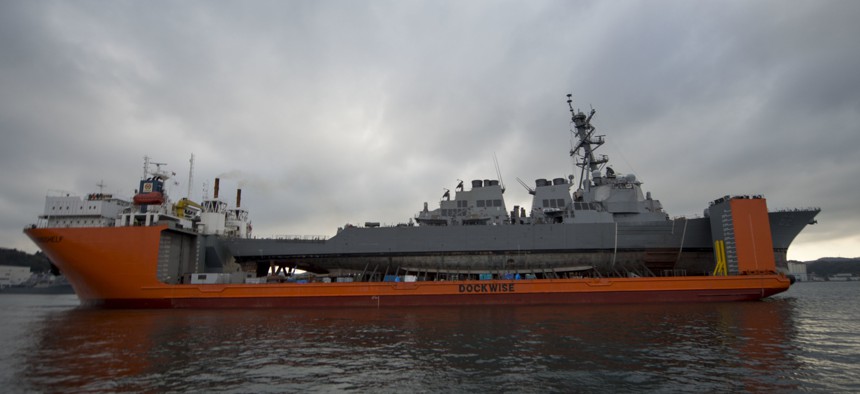
The Arleigh Burke-class guided-missile destroyer USS Fitzgerald aboard the heavy lift transport vessel MV Transshelf before being transported to Huntington Ingalls Industries for repairs. U.S. Navy photo by Mass Communications Specialist 1st Class Benjamin Dobbs
US Navy: More Ships, Tech, Training, Could Help Prevent Collisions at Sea
The comments come as the Pentagon prepares to submit a budget plan expected to call for increases in the size of the military.
U.S. Navy leaders say a combination of new ships, technology, and training will help prevent the kind of deadly collisions at sea that killed 17 sailors last year. The push for more warships comes as the Trump administration is finalizing a number of defense reviews and preparing to send a 2019 budget proposal to Congress.
“We’ve been advocating for a larger Navy, so that’s no mystery that we’re shooting to grow the Navy in all those dimensions,” Adm. John Richardson told reporters Tuesday at a Surface Navy Association-sponsored conference.
The chief of naval operations said a mix of “both training and technology and then the interface of the two” would help prevent incidents like the ones involving the destroyers USS Fitzgerald and USS John S. McCain, which collided with merchant ships in separate incidents in the Pacific.
At the conference, Vice Adm. Thomas Rowden, commander of Naval Surface Forces, called the collisions “preventable incidents,” echoing the Navy’s conclusions that they were due to lapses in basic seamanship.
“The review reinforced that the fleet is stretched and operational needs increasingly resulted in more time spent on operational missions then missions then on training, which ultimately led to an unacceptable normalization of deviation,” Rowden said.
The review also found that even though the Navy has put more money in recent years toward readiness, “these adds did not keep pace with the expanded demand for surface ships in the 7th Fleet,” Rowden said. “It reinforced the time-tested truth that familiarity with the resources on the bridge as well as the ship’s steering equipment and…is not to be learned on the fly, but practiced and drilled relentlessly.”
Rowden, who oversees U.S. ships in the Pacific, said sailors need help and time.
“Time to maintain their gear, time to refresh their basic individual and team skills and time to unwind,” he said. “Time will only come from one of two things, or a combination of them: More ships and fewer obligations. It’s hard to see it any other way.”
CNO Richardson said the Navy needs to take a “balanced approach" to growth.
“It is more than just the platform,” he said. “You do have to buy the crew to man that platform. You do have to buy the maintenance to invest and keep that platform current, you do have to do the logistics and the lifetime support, the parts, you have to have a place to park it. It’s this balanced, holistic approach that is defining our approach to growing the Navy so that we don’t build this great platform and then think after that: ‘OK, how are we going to man it?’”




